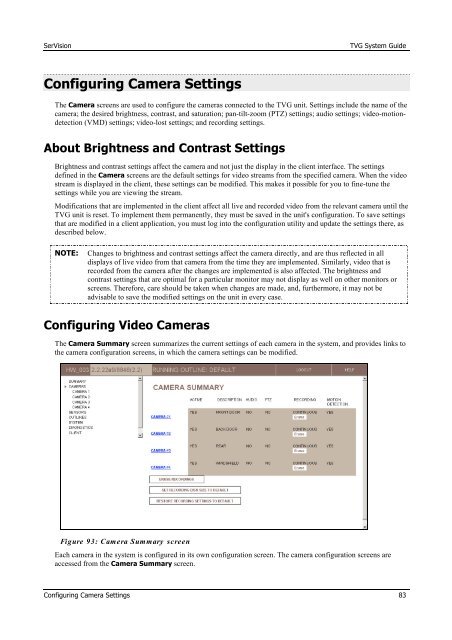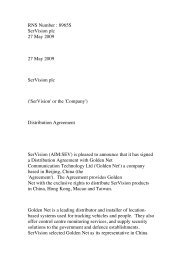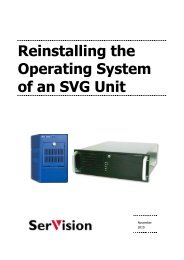TVG-Series System Guide v1-4 - SerVision
TVG-Series System Guide v1-4 - SerVision
TVG-Series System Guide v1-4 - SerVision
You also want an ePaper? Increase the reach of your titles
YUMPU automatically turns print PDFs into web optimized ePapers that Google loves.
<strong>SerVision</strong><br />
<strong>TVG</strong> <strong>System</strong> <strong>Guide</strong><br />
Configuring Camera Settings<br />
The Camera screens are used to configure the cameras connected to the <strong>TVG</strong> unit. Settings include the name of the<br />
camera; the desired brightness, contrast, and saturation; pan-tilt-zoom (PTZ) settings; audio settings; video-motiondetection<br />
(VMD) settings; video-lost settings; and recording settings.<br />
About Brightness and Contrast Settings<br />
Brightness and contrast settings affect the camera and not just the display in the client interface. The settings<br />
defined in the Camera screens are the default settings for video streams from the specified camera. When the video<br />
stream is displayed in the client, these settings can be modified. This makes it possible for you to fine-tune the<br />
settings while you are viewing the stream.<br />
Modifications that are implemented in the client affect all live and recorded video from the relevant camera until the<br />
<strong>TVG</strong> unit is reset. To implement them permanently, they must be saved in the unit's configuration. To save settings<br />
that are modified in a client application, you must log into the configuration utility and update the settings there, as<br />
described below.<br />
NOTE:<br />
Changes to brightness and contrast settings affect the camera directly, and are thus reflected in all<br />
displays of live video from that camera from the time they are implemented. Similarly, video that is<br />
recorded from the camera after the changes are implemented is also affected. The brightness and<br />
contrast settings that are optimal for a particular monitor may not display as well on other monitors or<br />
screens. Therefore, care should be taken when changes are made, and, furthermore, it may not be<br />
advisable to save the modified settings on the unit in every case.<br />
Configuring Video Cameras<br />
The Camera Summary screen summarizes the current settings of each camera in the system, and provides links to<br />
the camera configuration screens, in which the camera settings can be modified.<br />
Figure 93: Camera Summary screen<br />
Each camera in the system is configured in its own configuration screen. The camera configuration screens are<br />
accessed from the Camera Summary screen.<br />
Configuring Camera Settings 83





